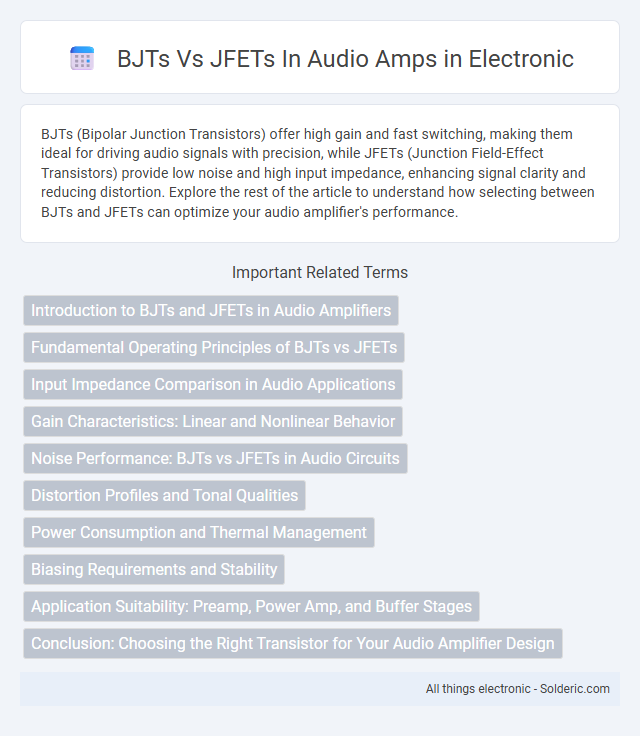BJTs (Bipolar Junction Transistors) offer high gain and fast switching, making them ideal for driving audio signals with precision, while JFETs (Junction Field-Effect Transistors) provide low noise and high input impedance, enhancing signal clarity and reducing distortion. Explore the rest of the article to understand how selecting between BJTs and JFETs can optimize your audio amplifier's performance.
Comparison Table
| Feature | BJT (Bipolar Junction Transistor) | JFET (Junction Field Effect Transistor) |
|---|---|---|
| Type | Current-controlled device | Voltage-controlled device |
| Input Impedance | Low to moderate (~kO to 100kO) | High (~MO) |
| Noise Performance | Higher noise, especially at low frequencies | Lower noise, preferred for low-noise audio stages |
| Linearity | Good linearity suitable for audio amplification | Excellent linearity, smooth clipping |
| Gain | High gain available | Moderate gain, but stable |
| Thermal Stability | Less thermally stable, requires bias stabilization | More thermally stable |
| Distortion Characteristics | Tends to produce even-order harmonics | Tends to produce odd-order harmonics, perceived as natural |
| Drive Requirements | Requires base current drive | Requires gate voltage, negligible current |
| Common Usage in Audio | Widely used in output stages and preamps | Preferred in input stages and low-noise amplifiers |
| Cost & Availability | Generally cheaper and more available | Typically more expensive, less common |
Introduction to BJTs and JFETs in Audio Amplifiers
BJTs (Bipolar Junction Transistors) and JFETs (Junction Field-Effect Transistors) are critical components in audio amplifier design, each offering distinct electrical characteristics that influence sound quality. BJTs provide high gain and fast switching suitable for dynamic audio applications, while JFETs deliver low noise and high input impedance, preserving signal purity. Understanding these differences helps you select the optimal transistor type to achieve the desired tonal warmth or clarity in your amplifier setup.
Fundamental Operating Principles of BJTs vs JFETs
BJTs (Bipolar Junction Transistors) operate based on current control, where a small base current modulates a larger collector current, providing high gain and fast switching suitable for audio amplification. JFETs (Junction Field Effect Transistors) function via voltage control, using an electric field to regulate the current flowing through a conductive channel, resulting in high input impedance and low noise characteristics essential for audio clarity. The fundamental difference in control mechanisms--current for BJTs and voltage for JFETs--directly influences their linearity, noise performance, and input impedance in audio amplifier applications.
Input Impedance Comparison in Audio Applications
BJTs typically offer lower input impedance, ranging from 1kO to 10kO, which can load audio signal sources and potentially affect tone quality in sensitive circuits. JFETs provide much higher input impedance, often exceeding 1MO, making them ideal for preserving signal integrity and reducing source loading in audio amplifier inputs. Your choice between BJTs and JFETs significantly impacts the input stage's interaction with the preceding audio source and overall sound fidelity.
Gain Characteristics: Linear and Nonlinear Behavior
BJTs exhibit high gain with strong linear amplification but can introduce nonlinear distortion at high signal levels, affecting audio fidelity. JFETs provide more linear gain characteristics with lower distortion due to their voltage-controlled operation and higher input impedance, making them favorable for clean signal amplification in audio circuits. Your choice depends on whether you prioritize higher gain (BJT) or smoother, more linear amplification (JFET) for optimal audio performance.
Noise Performance: BJTs vs JFETs in Audio Circuits
JFETs typically exhibit lower input noise voltage compared to BJTs, making them preferable for high-impedance audio signal sources where minimal noise is crucial. BJTs, while offering higher gain and better linearity, often produce more noise due to their current-driven operation and input bias currents. Your choice between BJTs and JFETs in audio amplifiers should consider the noise characteristics relative to the source impedance and desired signal purity.
Distortion Profiles and Tonal Qualities
BJTs in audio amplifiers typically produce higher harmonic distortion, resulting in a warmer and more aggressive tonal quality favored in rock and electric guitar applications. JFETs, known for their lower distortion and smoother transfer characteristics, deliver a softer, more natural sound often preferred in high-fidelity and ambient music setups. Your choice between BJTs and JFETs will impact the amplifier's character, with BJTs enhancing presence and edge, while JFETs emphasize clarity and warmth.
Power Consumption and Thermal Management
BJTs in audio amplifiers typically consume more power due to their higher quiescent current and require robust thermal management solutions such as heat sinks to dissipate generated heat effectively. JFETs, on the other hand, operate at lower power levels with reduced heat generation, enhancing energy efficiency and simplifying thermal design. This results in JFET-based amps being preferable for low-power, low-thermal-stress applications, while BJTs are often chosen for high-power, high-gain circuits despite increased thermal considerations.
Biasing Requirements and Stability
BJTs require precise biasing with stable current sources to maintain consistent gain and minimize thermal runaway in audio amplifiers. JFETs have simpler biasing needs due to their constant current characteristics, offering improved thermal stability and reduced distortion. Your choice impacts the amplifier's linearity and reliability depending on the biasing complexity and temperature sensitivity.
Application Suitability: Preamp, Power Amp, and Buffer Stages
BJTs offer high gain and fast switching, making them ideal for preamp and power amp stages where amplification and linearity matter most. JFETs provide low noise and high input impedance, which suits buffer stages and preamps requiring minimal signal distortion. Your choice depends on whether you prioritize gain accuracy or input sensitivity in each audio amplifier section.
Conclusion: Choosing the Right Transistor for Your Audio Amplifier Design
BJTs offer higher gain and faster switching, making them suitable for applications requiring strong amplification and precise control in audio amps. JFETs provide low noise and high input impedance, ideal for preserving audio signal integrity in high-fidelity designs. Your choice depends on whether you prioritize gain and speed or noise performance and input sensitivity in your audio amplifier design.
BJTs vs JFETs in audio amps Infographic

 solderic.com
solderic.com